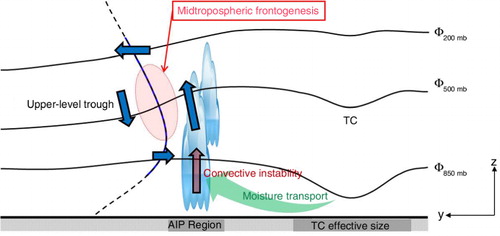Figures & data
Fig. 1 IR images from the GMS (upper panels) and rain rates (units: mm h−1) from the Tropical Rainfall Measuring Mission (TRMM) 3B42 V6 data together with the effective radius of TC (middle panels) at the peak time of the first rainfall (red arrows in the bottom panels). The bottom panels show the time series of hourly precipitation from surface station recorded maximum precipitation in South Korea during the period associated with the TCs for the three AIP cases: Bart (1999; left), Saomai (2000; middle) and Soudelor (2003; right).
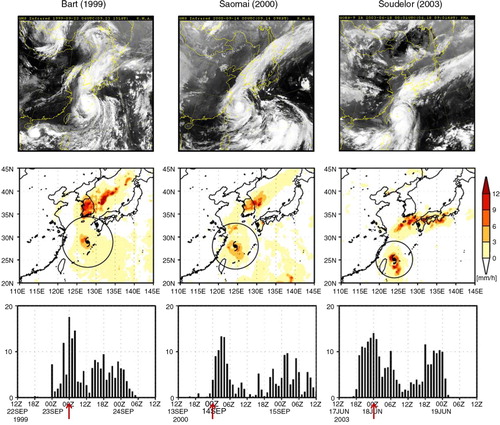
Fig. 2 Schematic of effective radius (R15) of TC, effective landfall time (LFT) and the station locations for direct precipitation (red crosses) and AIP (green crosses). Grey crosses denote the stations with no precipitation. Black line denotes TC track.
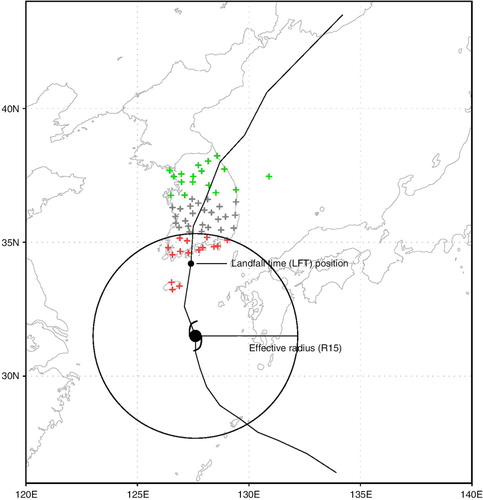
Fig. 3 Geopotential height (contour, units: gpm), QG frontogenesis [shading, units: 10−11 K (m s)−1] and horizontal winds (vector, units: m s−1) at (a, b) 500 hPa, and (c, d) 925 hPa and (e, f) the meridional–vertical cross-section of QG frontogenesis, potential temperature (thick contour, units: K) and pressure velocity (thin contour, units: Pa s−1) along 127.5°E at the maximum precipitation time for the representative two cases of RR-OT (Nari, 2007; left panel) and AIP (Saomai, 2000; right panel), respectively. The black triangle and TC symbol indicate the precipitating region and composite TC location, respectively.
![Fig. 3 Geopotential height (contour, units: gpm), QG frontogenesis [shading, units: 10−11 K (m s)−1] and horizontal winds (vector, units: m s−1) at (a, b) 500 hPa, and (c, d) 925 hPa and (e, f) the meridional–vertical cross-section of QG frontogenesis, potential temperature (thick contour, units: K) and pressure velocity (thin contour, units: Pa s−1) along 127.5°E at the maximum precipitation time for the representative two cases of RR-OT (Nari, 2007; left panel) and AIP (Saomai, 2000; right panel), respectively. The black triangle and TC symbol indicate the precipitating region and composite TC location, respectively.](/cms/asset/00d111a4-44fd-4db6-ad5c-ceea98867155/zela_a_11817079_f0003_ob.jpg)
Table 1. List of all documented AIP cases over the KP from 1993 to 2004
Table 2. List of all documented non-AIP cases over the KP from 1993 to 2004
Table 3. Monthly occurrence numbers of AIP, non-AIP, and total cases and the monthly ratio of AIP to total (units: %)
Fig. 4 Locations (black TC symbols) and tracks (red line) of the TCs at the analysis time for (a) the AIP and (b) non-AIP cases. The black point and black circle denote mean location and mean effective size for each case, respectively.
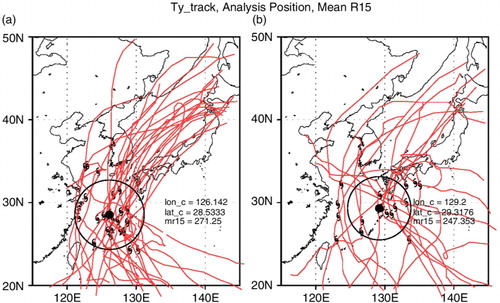
Fig. 5 Composite fields of geopotential height (black contour, units: gpm), temperature (red contour, units: K) at 200 hPa (a, b), 500 hPa (c, d) and 850 hPa (e, f) for the AIP (left panels) and non-AIP cases (right panels) at their respective analysis time. Shadings represent 200 hPa wind speed (units: m s−1) in (a, b), 500 hPa horizontal winds (arrows, units: m s−1) and convergence (units: 10−5 s−1) in (c, d) and 850 hPa specific humidity (units: g kg−1) in (e, f). Thick contours in (e, f) indicate the line at 1480 gpm. Dots denote the 90% significant region of the shading by the Student's t-test.
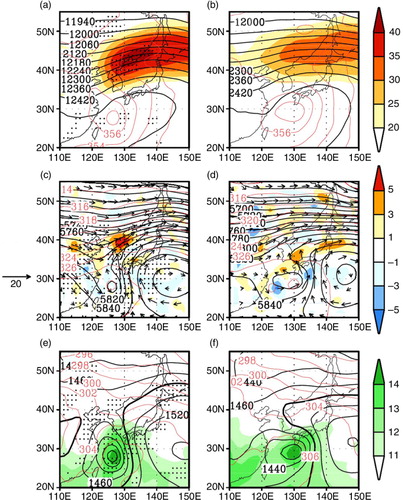
Fig. 6 Composite fields of (a) QG frontogenesis [shading, units: 10−11 K (m s)−1], streamline and omega (contour, negative dashed, units: Pa s−1) averaged between 700 and 400 hPa, and (b) (shading, units: 10−16 K2 m−2 s−1),
[vector, units: K (m s)−1],
convergence (contour, units: K m−2 s−1) at the analysis time. The dashed green (blue) rectangular indicates the frontal (ascending) region, which will be used for area-average (see the text). Colour shadings denote the 90% significant region of the shading by Student's t-test. The TC symbol indicates the composite TC location.
![Fig. 6 Composite fields of (a) QG frontogenesis [shading, units: 10−11 K (m s)−1], streamline and omega (contour, negative dashed, units: Pa s−1) averaged between 700 and 400 hPa, and (b) Q→∇pθ (shading, units: 10−16 K2 m−2 s−1), Q→ [vector, units: K (m s)−1], Q→ convergence (contour, units: K m−2 s−1) at the analysis time. The dashed green (blue) rectangular indicates the frontal (ascending) region, which will be used for area-average (see the text). Colour shadings denote the 90% significant region of the shading by Student's t-test. The TC symbol indicates the composite TC location.](/cms/asset/6731d385-57af-40f2-bbcd-c80d0eb829fe/zela_a_11817079_f0006_ob.jpg)
Fig. 7 Composite fields of various terms of the QG omega equation (shading, units: 10−12 Pa m−2 s−1) and potential temperature (red contour, units: K) averaged between 700 and 400 hPa. (a) Three-dimensional Laplacian of composite omega [LHS of eq. (3)], (b) sum of all forcing terms [RHS of eq. (3)] (total forcing), (c) sum of QG forcing terms, (d) diabatic forcing terms, (e) differential geostrophic vorticity advection term and (f) the Laplacian of potential temperature advection term.
![Fig. 7 Composite fields of various terms of the QG omega equation (shading, units: 10−12 Pa m−2 s−1) and potential temperature (red contour, units: K) averaged between 700 and 400 hPa. (a) Three-dimensional Laplacian of composite omega [LHS of eq. (3)], (b) sum of all forcing terms [RHS of eq. (3)] (total forcing), (c) sum of QG forcing terms, (d) diabatic forcing terms, (e) differential geostrophic vorticity advection term and (f) the Laplacian of potential temperature advection term.](/cms/asset/d87154f5-1c67-4768-aed0-f82bc946aa03/zela_a_11817079_f0007_ob.jpg)
Fig. 8 Composite fields of (a) moisture flux (vector, units: m s−1) and its convergence (shading, units: s−1) averaged between 900 and 500 hPa at the analysis time, (b) meridional–vertical cross-section of specific humidity (shading, units: g kg−1), moisture flux (vector) by meridional wind components (units: m s−1) and negative pressure velocity (units: 30×Pas−1), and meridional moisture flux convergence (contour, units: s−1) along 127.5°E. Colour and green shadings denote the 90% significant region of the shading by Student's t-test. The TC symbol indicates the composite TC location and the triangle in (b) indicates the mean latitude (36.04°N) of surface stations in South Korea (i.e. the AIP region).
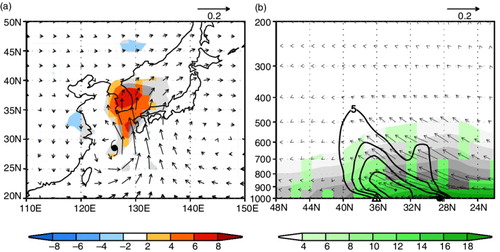
Fig. 9 Meridional–vertical cross-section of total frontogenesis (shading, units: 10−11 K m−1s−1), potential temperature (thin contours, units: K) and pressure velocity (thick contours, units: Pas−1) along 127.5°E. Arrows indicate the flow parallel to the cross-section (the horizontal component in m s−1 and vertical component in 30 Pas−1). Colour shadings denote the 90% significant region by Student's t-test. The TC symbol and triangle are the same as in .

Fig. 10 Scatter plots: (a) between precipitation [units: mm (6 h) −1] averaged for all stations in South Korea and pressure velocity (units: Pas −1) averaged over the ascending region (blue box in a), (b) between QG frontogenesis (units: 10 −11 K m −1 s −1) averaged over the frontal region (green box in a) and pressure velocity and (c) between QG frontogenesis and precipitation. All plots use the values at the analysis time.
![Fig. 10 Scatter plots: (a) between precipitation [units: mm (6 h) −1] averaged for all stations in South Korea and pressure velocity (units: Pas −1) averaged over the ascending region (blue box in Fig. 6a), (b) between QG frontogenesis (units: 10 −11 K m −1 s −1) averaged over the frontal region (green box in Fig. 6a) and pressure velocity and (c) between QG frontogenesis and precipitation. All plots use the values at the analysis time.](/cms/asset/dfd15f1a-b917-4f29-9e36-c5229061cbcf/zela_a_11817079_f0010_ob.jpg)
Fig. 12 Composite fields of geopotential height (contour, units: gpm), QG frontogenesis [shading, units: 10−11K (m s)−1] and horizontal winds (vector, units: m s−1) at (a) 200 hPa, (b) 500 hPa and (c) 925 hPa for the AIP cases at the analysis time. The colour shadings and thick arrows represent the 90% significant region by Student's t-test.
![Fig. 12 Composite fields of geopotential height (contour, units: gpm), QG frontogenesis [shading, units: 10−11K (m s)−1] and horizontal winds (vector, units: m s−1) at (a) 200 hPa, (b) 500 hPa and (c) 925 hPa for the AIP cases at the analysis time. The colour shadings and thick arrows represent the 90% significant region by Student's t-test.](/cms/asset/7f04b8a2-49ad-46bc-9747-7bd90a448bc3/zela_a_11817079_f0012_ob.jpg)
Fig. 13 Geopotential height (contour, units: gpm), QG frontogenesis [shading, units: 10−11 K (m s)−1] and horizontal winds (vector, units: m s−1) at (a, b, c) 200 hPa, (d, e, f) 500 hPa, and (g, h, i) 925 hPa and (j, k, l) meridional–vertical cross-section of QG frontogenesis, potential temperature (thick contours, units: K) and pressure velocity (thin contours, units: Pa s−1) along 127.5°E at the maximum precipitation time for the composite fields of AIP (left panel), RR-OT (middle panel) and PRE-SJ (right panel), respectively. The black triangle and TC symbol in the bottom panel indicate the precipitating region and composite TC location, respectively.
![Fig. 13 Geopotential height (contour, units: gpm), QG frontogenesis [shading, units: 10−11 K (m s)−1] and horizontal winds (vector, units: m s−1) at (a, b, c) 200 hPa, (d, e, f) 500 hPa, and (g, h, i) 925 hPa and (j, k, l) meridional–vertical cross-section of QG frontogenesis, potential temperature (thick contours, units: K) and pressure velocity (thin contours, units: Pa s−1) along 127.5°E at the maximum precipitation time for the composite fields of AIP (left panel), RR-OT (middle panel) and PRE-SJ (right panel), respectively. The black triangle and TC symbol in the bottom panel indicate the precipitating region and composite TC location, respectively.](/cms/asset/a51da795-eee9-4a0f-b661-af8aaeb505b3/zela_a_11817079_f0013_ob.jpg)
Table 4. Summary of relevant characteristics of TC and frontogenesis among the AIP, RRE, and PRE cases

